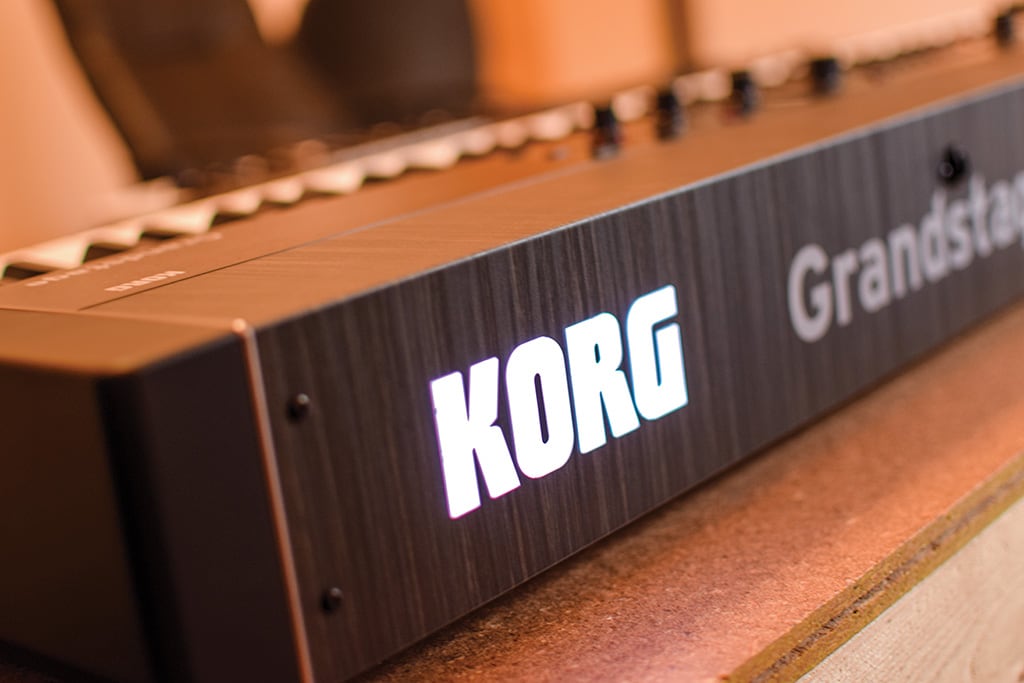
Review: Korg Grandstage
Korg keyboards are heavyweights in both market position and gravitational pull. The new Grandstage has a significantly smaller stand-print than the flagship Kronos LS we reviewed a few months ago but still weighs close to a toddler hippo. Power it up, though, and your aching back will soon be forgotten. It’s a true delight to anyone seeking an authentic piano playing experience.
Before getting too far into this review, I can’t fail to mention the ‘loudest’ design feature of the keyboard — an unmissable backlit Korg logo in the front panel that instantly turns the Grandstage into an extra lighting fixture at a gig. What’s more, you can activate Cycle mode where it transitions through different colours, or even better, make it flash when you hit the keys — a trick for the party bangers in your set that’ll either make you very cool or a social pariah! If you’d rather not have every performance turn into a flamboyant Korg advertisement, there’s an option to dim the backlight or turn it off altogether.
TWO BLOCKS
Available in both 73- and 88-key variations, the sounds of the Grandstage are generated by seven separate engines — SGX-2 for acoustic pianos, EP-1 for electric pianos, CX-3, VOX, and Compact for organs, AL-1 analogue modelling, and the HD-1 PCM engine.
All those sounds (500 of them) are served up via two partitions on the dashboard, the Ensemble and Keyboard sections, which can be individually turned on or off. Both sections have their own sound selection dial, Variation dial to scroll through presets, Level dial, and a small screen readout to display the preset name and edit parameters. Best treated as building blocks, Ensemble and Keyboard sounds can join hands using the Layer or Split buttons. Selecting a split point is easy and you can balance dual voice sounds with the level controls.
It’s a fantastic layout that lends itself to quick blends of a huge variety of sounds without needing to deep dive into menus. The Favourite section lets you store 64 user-made patches, giving plenty of space to accumulate your custom collection. A Panel Lock button keeps your tone secure from wandering digits during shows.
NEED TO KNOW
Korg Grandstage
Digital Stage Piano

GRAND ON STAGE
Grandstage’s piano presets will satisfy even the most discerning players. Options available are broken down by country of origin; Japanese, German, Austrian, etc.; and both upright and grand piano models feel rich and lush on the impeccably-weighted RH-3 hammer action keybed. Authentic Rhodes and Wurlitzer tones are found in the EP RD and EP WL selections. Pressing the Edit button gives you control over pre-selected parameters relevant to the patch you’re on.
Organ sounds turn the pitch bend wheel into a on/off control that mimics the switch on a rotary cab. The modulation wheel becomes a volume slider, so it’s pretty easy hacking a Hammond sound — minus the drawbars, of course — if you get good at using the extra expressive options.
On the synthesis front, you could spend a week trawling through the variety of basses, leads, pads, bells, SFX and other eclectic sounds on offer. They’re great fun to play, albeit not very manipulable — but that’s the whole point… Grandstage isn’t trying to be a synth. I enjoyed the pads in particular. Texturally there’s everything you could ask for and you can pull some neat sounds by creatively combining both Ensemble and Keyboards sections. The screens are tiny but sufficient for the limited control you’re given.
If there was a weak point in this thing, it would be the orchestral sounds. For the most part any kind of string ensemble patch felt thin and a bit cheap and I found myself winding down the LPF cutoff to ease back graininess in the top end. Same deal with brass sections, though some french horn and trombone patches sounded magnificent after a little EQ adjustment and a dousing of reverb. Having a measure of tonal control over the patches is handy but if you’re a tweak-freak you’ll possibly wind up craving more editability.
BRUSHING UP
Like the two sound sections, the Effects section is super easy to navigate and minimal controls means you don’t waste time surfing menus. Four individual reverbs and delays present a heap of flavours ranging from a tight room reverb to colourful modulated delays, synced effortlessly with the tap tempo button. The effects are global, so they apply to both Keyboards and Ensembles sounds alike.
The Dynamics knob is an invaluable addition, especially for the piano sounds. Rotate left for more delicate expression when playing classical pieces, spin to the right for pop or rock tunes. The global three-band EQ is a quick and musical way to compensate for differing PAs at gigs, or you could use the EQ on/off button as a one-push tone alteration option.
At around $3.5k, the Korg Grandstage isn’t cheap, and its library of sounds isn’t as expansive as some may expect for the price tag. But this instrument is all about delivering the highest quality digital stage piano experience Korg can offer. Acoustic piano sounds are Grandstage’s sweet spot — you’ll find plenty else out there if you’re after synth sounds, orchestral emulations, or even electric pianos. So if you’re willing to treat everything besides piano tones as a bonus, Grandstage will impress. Leave it sitting on stage at a school concert hall, church, performing arts venue, or wherever else a miked up baby grand isn’t feasible, and there’ll be no regrets.
















RESPONSES